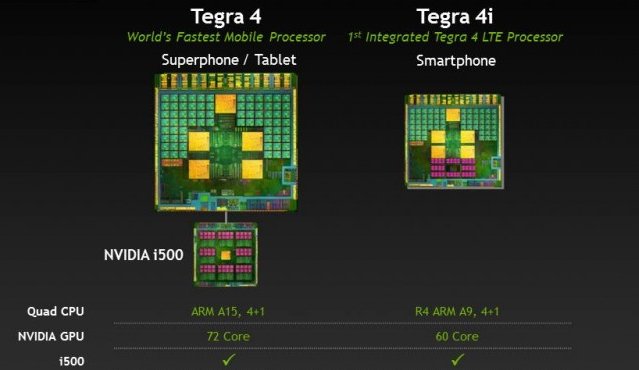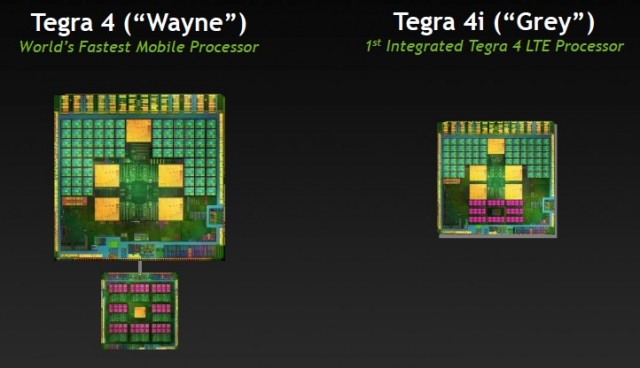
Tegra 4 and Tegra 4i—different chips for different markets.
When Nvidia announced its new Tegra 4 system-on-a-chip at CES last month, there was still a piece of the puzzle missing. Tegra 4, with its four ARM Cortex-A15 CPU cores and 72 GPU cores, is unquestionably a high-performance chip relative to its competition, but with higher performance comes higher power consumption. Tegra 4 can also be combined with Nvidia's new i500 LTE modem, but the modem is a separate chip rather than one that's integrated directly into the SoC.
This sort of a chip will serve both tablets and high-end smartphones well enough—both the Nexus 4and LG's Optimus G use a similar combination of Snapdragon processors and modem chips—and Nvidia's slides are careful to point out that these are the devices that Tegra 4 is intended for. However, such a chip works less well for phones that want decent performance but also need to prioritize battery life. For those phones, a single SoC with an integrated modem is generally the preferable choice—the BlackBerry Z10 and most Windows phones go this route.
We've known all along that Nvidia planned to introduce another chip, codenamed Project Grey, to serve this market, but so far we haven't heard much else about it. That changes today: ahead of next week's Mobile World Congress, Nvidia has announced details for Project Grey, now named Tegra 4i and set to launch later this year. The chip looks like a much better fit for smartphones than Tegra 3 ever was—let's look at the details.
The CPU

Tegra 4i is a 28nm SoC with all of the important smartphone parts—CPU, GPU, and LTE modem—integrated into a single 12mm by 12mm die.
Let's start with the CPU, the five large golden squares in the die shot above. As in other Tegra SoCs, Tegra 4i uses four CPU cores for most of its processing, but also includes a fifth power-saving "companion" core that is engaged only when your device is idle or asleep. The companion core cannot be enabled when any of the other four CPU cores are being used, and vice-versa.
Unique to Tegra 4 is the architecture of the CPU cores—where Tegra 3 uses ARM's Cortex-A9 architecture and Tegra 4 uses Cortex-A15, Tegra 4i uses something called Cortex-A9 R4. We don't know a lot about exactly how this architecture will perform relative to other Cortex-A9 chips, but it's more likely to be a small jump than a generational leap—Tegra 4i's CPU cores will almost certainly be quicker than Tegra 3's cores at the same clock speed, but both will fall short of the cores used in the full Tegra 4.
To help Cortex-A9 fight against newer architectures from the likes of Qualcomm, Nvidia is ramping up the clock speeds relative to Tegra 3—Tegra 4i will have single-core CPU speeds of up to 2.3GHz, much higher than the 1.7GHz maximum in (non-overclocked) Tegra 3 SoCs. The clock speed when two-to-four of the CPU cores are engaged will undoubtedly be lower, but Nvidia isn't publicizing that number at this point (in Tegra 3, the difference was usually only 100MHz, so it may not even be a large drop).
Tegra 4i's CPU cores aren't going to set performance records, and that will be doubly true in late 2013 after Qualcomm's 600- and 800-series Snapdragon chips have had some time to proliferate. The 4i will improve significantly on Tegra 3, though, putting the SoCs CPU performance firmly in "good enough" territory.
The GPU
The Tegra 4i's GPU performance should get a more impressive generational bump from Tegra 3—it uses the same custom Nvidia GPU cores as Tegra 4, but cuts their number down to 60 from 72. There were 12 GPU cores in Tegra 3, which Nvidia strongly suggests should result in five-times-higher performance.
Do keep in mind, though, that the number of cores is only going to be one part of the graphics performance equation—the chip's memory interface will also be important here, and it's a safe bet that Tegra 4i will have a bit less memory bandwidth than Tegra 4 proper. Compare it to Apple's SoCs—the Apple A5X for the first Retina iPad added another pair of Imagination Technologies GPU cores, but to keep that high-resolution screen running smoothly it also used a 128-bit, quad-channel memory controller, up from the dual-channel controller in the older A5. We don't know the details of Nvidia's memory controllers yet, but expect something similar to happen here.
The clock speed of the GPU cores is also an unknown, but will probably be a bit lower in Tegra 4i relative to Tegra 4 proper. The takeaway is that Tegra 4i's GPU will be much faster than Tegra 3's (and a much larger bump than the CPU side of the chip gets), but in both number of GPU cores and memory interface it will still be a fair bit behind Tegra 4 proper.
The modem

Compare the separate i500 modem below the Tegra 4 chip to the fuchsia cores that represent the i500 modem in the Tegra 4i—they're the same modem, and they share the same capabilities.
Finally, we're at what may be the most important part for Nvidia's smartphone strategy—the modem. So far, Qualcomm has essentially cornered the mid-to-high-end smartphone market in the US, not just because of its generally good performance but also because most of its chips feature an integrated LTE modem. This is one reason why phones released in the US often use Snapdragon SoCs despite using different SoCs in their international versions, and as Nvidia's first chip with an integrated LTE modem the Tegra 4i should help the company win some of that business.
There is no difference in features between the modem integrated into the Tegra 4i and the separate version offered for use with the Tegra 4—a look at the die shots for both chips shows the same number of execution resources, and both modems share the i500 model number. Thus, our earlier observations about the modem in the Tegra 4 apply here:
And the rest

Nvidia will be using its "Phoenix" reference phone to show Tegra 4i off to its partners.
Moving beyond the hard specifications for a moment, Tegra 4i also includes a few of the other multimedia features advertised with Tegra 4: the always-on HDR camera (now named the Nvidia Chimera Computational Photography Architecture) and the video-encoding/-decoding engine are the two most important.
It will probably be a while before we see Tegra 4i in any shipping, consumer-ready products, but Nvidia does have some hardware that it's sampling to its partners to show off the new chip: its reference phone is codenamed "Phoenix" (do you see what they did there), and the picture above is basically all we know about it. Nvidia will be showing off Tegra 4i (and, one assumes, the Phoenix reference phone) at Mobile World Congress next week—we'll be meeting with Nvidia, and we'll update you with any additional details we can get.
No comments:
Post a Comment
Let us know your Thoughts and ideas!
Your comment will be deleted if you
Spam , Adv. Or use of bad language!
Try not to! And thank for visiting and for the comment
Keep visiting and spread and share our post !!
Sharing is a kind way of caring!! Thanks again!